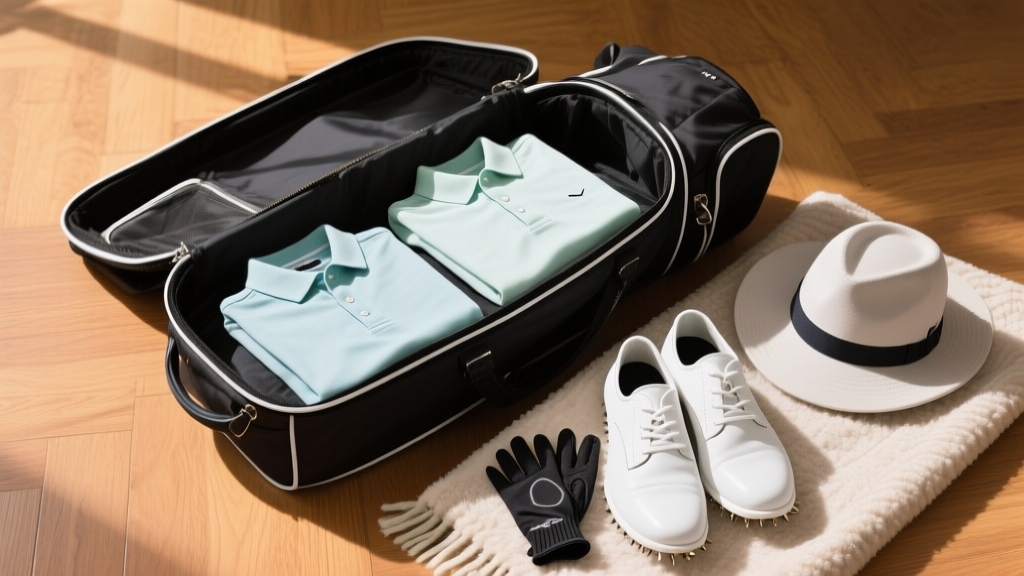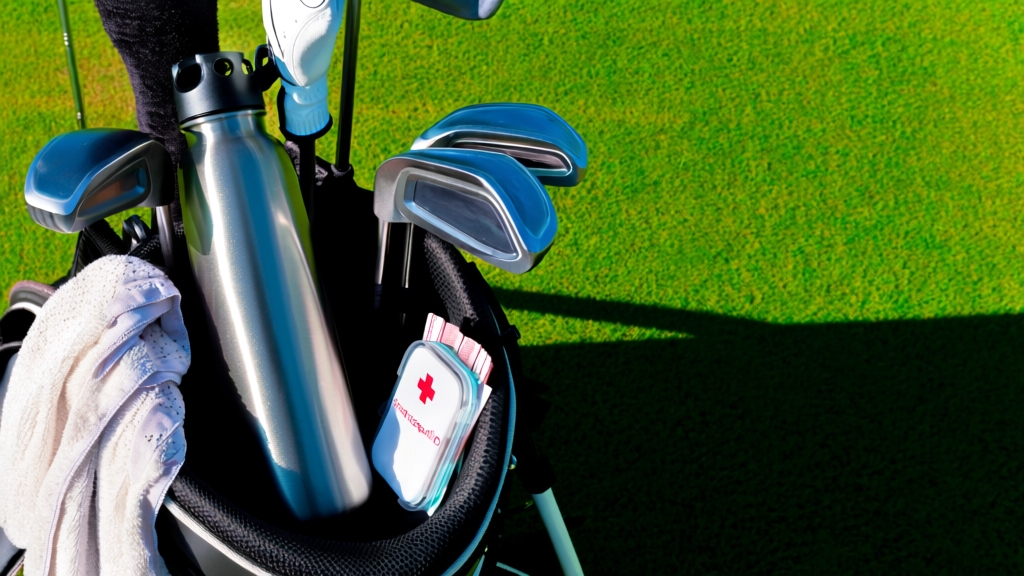You’ll want a sturdy travel bag with padded protection and TSA-approved locks to safeguard your clubs, plus headcovers and organized tees. Pack versatile golf shoes and moisture-wicking apparel for changing weather, along with sun protection like hats and sunscreen.
Don’t forget essential accessories—gloves, rangefinders, and a golf towel—to keep your game sharp. Stay hydrated with water and snacks for energy. Keep these basics in mind, and you’ll be ready for a smooth, enjoyable golf trip experience.
- Key Takeaways
- Selecting and Preparing Your Golf Clubs and Bag
- Choosing the Right Golf Balls and Tees
- Packing Golf Shoes and Appropriate Apparel
- Essential Golf Accessories and Technology
- Health and Comfort Items for the Course
- Tips for Organizing and Protecting Your Equipment
- Managing Travel Logistics for Golf Gear
- Strategies for Staying Hydrated and Energized
- Frequently Asked Questions
- How Do I Handle Customs When Traveling Internationally With Golf Clubs?
- What Insurance Options Cover Loss or Damage to Golf Equipment During Travel?
- Can I Rent Golf Clubs at My Destination Instead of Bringing My Own?
- How Early Should I Arrive at the Airport With Golf Gear for Check-In?
- Are There Specific Airline Fees for Transporting Golf Bags and Clubs?
- Don’t Forget the Golf Essentials: Tees, Gadgets, and Health Must-Haves
Key Takeaways
- Pack a well-organized golf bag with clubs secured using padded headcovers, internal straps, and TSA-approved locks for travel protection.
- Bring a variety of golf balls and tees suited to your skill level and course conditions, plus essential accessories like ball markers and divot tools.
- Include weather-appropriate apparel such as moisture-wicking layers, waterproof jackets, golf shoes with good traction, and sun-protection gear like hats and sunglasses.
- Carry hydration supplies like electrolyte water and light snacks, along with high-SPF sunscreen, insect repellent, and comfort items like gloves and towels.
- Prepare for travel logistics by choosing a sturdy, wheeled golf travel bag, understanding airline policies, and using rain covers and GPS tracking if needed.
Selecting and Preparing Your Golf Clubs and Bag

When selecting and preparing your golf clubs and bag for a trip, choosing the right travel bag is essential to protect your equipment and simplify transport.
You’ll want to pick between hard cases, which offer maximum protection with industrial-strength latches, TSA locks, and integrated wheels, or soft travel bags that are lighter but require padded straps for club security. Using tie-downs and straps properly inside the bag can add an extra layer of security during transport.
Look for TSA-approved locks and rain covers to safeguard your clubs during airport checks and unpredictable weather.
Inside, separate driver heads with headcovers and use thick foam padding to shield shafts and clubheads. Unscrew driver and fairway wood heads; note or photograph settings for reassembly to ensure you can easily restore your clubs after travel.
Organize clubs so heavier ones sit at the bottom, maintaining balance and reducing damage risk. Avoid overpacking non-club items unless your bag has designated compartments, especially in hard cases, to keep everything secure and well-protected.
Choosing the Right Golf Balls and Tees
When packing for your golf trip, choosing the right golf balls tailored to your swing speed and skill level can make all the difference in performance. Modern golf balls come in various constructions, such as three-piece, four-piece, and five-piece models, each designed to optimize distance, spin, and feel for different players’ needs (golf ball construction).
Consider whether you prefer a ball with a matte finish or a regular shiny surface, as this can affect spin and visibility on the course.
Bring a variety of tees in different lengths to suit your drivers and irons. This ensures you’re always set up for the perfect shot. Having the right mix of balls and tees keeps you prepared for any course conditions you might face.
Consider packing extra balls and tees to avoid running out during your round. Selecting equipment that matches your playing style helps enhance your overall game experience.
Selecting Ball Types
Although selecting the right golf balls might seem straightforward, choosing one that matches your swing speed, playing style, and course conditions can considerably impact your game.
For example, if you swing slower, a softer ball with compression under 70 enhances distance and feel. Faster swingers benefit from firmer balls (compression 90+) for better control. Our expert testing found that compression range directly affects both distance and spin characteristics, making it key to select accordingly.
You’ll also want to consider spin: high-spin balls improve greenside control, while low-spin balls maximize tee distance.
| Ball Type | Best For |
|---|---|
| 2-Piece | Beginners, distance |
| 3-Piece | Intermediate, all-around |
| 4+ Piece | Pros, spin control |
Urethane covers offer a soft feel and spin, ideal for better players. Choose wisely to boost your performance on the course!
Tees Quantity and Variety
Since your tee choice directly affects your shot quality, packing a variety of tee lengths and styles is essential for any golf trip. Carry tees ranging from 1.5 to 4 inches to suit every club and hole length—longer tees for drivers, shorter ones for irons and wedges.
Bringing about 30 to 40 tees ensures you have enough for each round, including extras for breakage or loss. Mix wood tees for tradition with durable plastic or brush tees to handle tough turf. Don’t forget specialty tees with colored bands that help maintain consistent height.
Proper tee height boosts launch and spin. Practice setting the ball so its middle aligns just above the driver’s clubface top. This variety and preparation help you adapt quickly, improving your consistency across diverse courses and conditions.
Additionally, organizing your tees and other small accessories in designated sections of your golf bag enhances time efficiency during your rounds.
Packing Golf Shoes and Appropriate Apparel

You’ll want to pack golf shoes that fit comfortably and offer solid traction for every swing. Selecting apparel that adapts to changing weather keeps you dry, cool, and ready to play your best.
Understanding your handicap can also help you choose gear tailored to your level of play. Bringing essentials like Chinos and Polo Tops ensures you stay stylish and meet course dress codes. With the right shoes and clothing, you’ll feel confident and prepared on any course.
Choosing Comfortable Golf Shoes
When packing for a golf trip, choosing comfortable golf shoes is essential to make certain you stay supported and pain-free throughout long days on the course. Focus on shoes that combine ergonomic soles with premium orthotic insoles to cushion every step and maintain proper foot alignment.
Selecting the right footwear can also help prevent foot soreness which is common during extended play. Opt for wide toe boxes and padded interiors to prevent pressure points and allow natural toe movement.
Select lightweight, breathable materials that also offer waterproofing for all-weather readiness. Prioritize upper materials that balance waterproofing and breathability to keep feet dry yet cool.
Ensure shoes have sturdy midsoles for swing support and treads that provide reliable traction without sacrificing comfort. Bring removable insoles or custom orthotics to tailor fit and enhance shock absorption.
Selecting Weather-Appropriate Apparel
Although packing golf shoes is essential, selecting weather-appropriate apparel completes your preparation by ensuring comfort and performance on the course.
For warm days, choose moisture-wicking, breathable fabrics like polyester or lightweight cotton in light colors to reflect heat. Incorporate UPF 50+ clothing and accessories like wide-brim hats and UV-protective sunglasses for sun safety.
Golfers often find that the right grip size can also affect their swing comfort in hot weather, enhancing overall play with better clubhead control. When cooler or variable weather strikes, layer a breathable base, collared polo, and light sweaters or windproof jackets.
Don’t forget stretch golf pants or tailored shorts, depending on temperature and dress codes. Selecting weather-resistant fabrics such as polyester and nylon blends can provide both water resistance and wind protection, enhancing your comfort in changing conditions.
Carry extras such as moisture-wicking socks, waterproof gear, and polarized sunglasses to stay dry and maintain visibility. Prioritize quick-drying, stretchable materials that allow full swing motion and adapt easily to changing weather conditions.
Essential Golf Accessories and Technology
Since every shot counts on the course, bringing the right golf accessories and technology can considerably enhance your game. These tools not only improve your accuracy but also keep you organized and comfortable.
- Golf Balls & Tees: Carry at least 9-10 balls and around 10 tees to avoid shortages. Use ball markers and divot tools to maintain pace and course etiquette. Affordable, durable golf balls are ideal for beginners to help keep costs down while learning.
- Rangefinders & GPS Devices: These gadgets provide precise distances and course layouts, helping you choose the right club and speed up play. Combining technology with proper club grip can further enhance your control and shot accuracy.
- Golf Gloves & Shoes: Gloves improve grip and swing control. Quality shoes offer stability and comfort on varying terrains. Wearing a golf glove can also prevent blisters and improve your grip during swings.
- Golf Bag: Opt for a lightweight, durable bag with multiple dividers and pockets. This helps organize your clubs and accessories efficiently throughout your trip. Consider bags like stand bags that offer versatility for carrying or using with a cart.
Health and Comfort Items for the Course

Because your comfort and health directly impact performance, packing the right items for sun protection, hydration, and weather preparedness is essential on any golf trip.
Bring high-SPF spray sunscreen and reapply every few hours to shield your skin without slippery grips. A golf hat, SPF lip balm, and UV-protective sunglasses reduce sun damage and eye strain.
Stay hydrated with a large water bottle, adding electrolytes to prevent cramping, and pack light snacks like nuts or energy bars for sustained stamina. Prepare for weather changes with a golf umbrella, rain jacket, and layered clothing. Don’t forget bug spray for insect relief.
For comfort, carry golf towels to manage sweat and keep your grip secure, and use glove protection, especially in humid conditions, to avoid blisters and maintain control. If your grips become wet during play, using a golf towel to dry them quickly can help maintain a firm hold and improve your game.
Tips for Organizing and Protecting Your Equipment
Keeping yourself comfortable and protected on the course matters just as much as safeguarding your golf gear during travel.
To organize and protect your equipment effectively, start by choosing the right travel bag. Hard-shell bags with padded interiors and internal straps offer excellent protection.
Many golfers prefer bags made with Military Grade Ballistic Nylon for added durability and padding. Regular maintenance of grips, such as cleaning and sanding, can also help preserve equipment performance during trips.
When packing, remove heads from adjustable clubs and position shafts upside down to minimize damage. Secure clubs tightly and use internal supports to prevent shifting. Finally, protect your clubs with headcovers and padded pockets.
Consider adding a wooden dowel inside the bag to guard against crushing.
- Select a hard-shell bag with padded interiors and immobilizing straps.
- Remove and separately pack adjustable club heads.
- Tighten club arrangement and use stiff internal supports.
- Use headcovers and internal reinforcements to cushion clubs.
Managing Travel Logistics for Golf Gear
When planning your golf trip, managing travel logistics for your gear guarantees a smooth experience from start to finish. Start by selecting a padded, durable golf travel bag with wheels to protect your clubs and ease transport.
Be sure to clean clubs thoroughly before packing to maintain their performance and appearance. Using proper packaging materials can prevent damage during transit and ensure your clubs arrive safely.
Reinforce soft-sided cases with a travel bag backbone, and wrap removable club heads and wood shafts in towels or headcovers to prevent damage. Research airline policies on size, weight, and fees to avoid surprises.
Consider shipping clubs ahead or using GPS trackers for peace of mind. If flying, confirm baggage limits and secure travel insurance to cover your gear. When driving, pad your trunk storage to avoid rattling.
Finally, pack golf clothes separately and create a checklist to ensure nothing’s forgotten before you hit the road.
Strategies for Staying Hydrated and Energized
Packing your golf gear carefully sets the stage for a great trip, but maintaining your energy and hydration during play makes all the difference on the course. Dehydration, even as little as 1%, can reduce your accuracy and increase fatigue, so staying properly hydrated is key.
Just a 1% drop in hydration can impair your accuracy and boost fatigue—stay hydrated to perform your best.
Here’s how to keep your energy and hydration on point:
- Drink 5-7 ml/kg of fluid within 4 hours before teeing off to start hydrated.
- Sip about 120 ml per hole during play, focusing on electrolyte-rich fluids in hot weather. Individual sweat rates and environmental conditions can significantly affect hydration needs, so tailor your fluid intake accordingly hydration strategies.
- Snack on light carbs and protein between holes to sustain energy without sluggishness.
- Rehydrate post-round by replacing 1.5 L of fluid per kg lost to recover fully.
Following these strategies will help you stay sharp and energized throughout your round.
Frequently Asked Questions
How Do I Handle Customs When Traveling Internationally With Golf Clubs?
Don’t let customs catch you off guard when traveling with golf clubs. First, research your destination’s import rules carefully. You’ll need accurate inventories, proof of purchase, and possibly special forms.
Pack your clubs securely, label them clearly, and prepare for potential duties or taxes. Use trusted shipping services and consider insurance for peace of mind. Staying organized and informed guarantees your clubs arrive safely without delays or extra fees.
What Insurance Options Cover Loss or Damage to Golf Equipment During Travel?
You can protect your golf gear with specialized golf travel insurance or general travel insurance that covers sports equipment. These plans reimburse you for lost, stolen, or damaged clubs, bags, and shoes, sometimes up to $3,000.
Some plans even cover rental gear expenses or non-refundable green fees if your game’s canceled. For ultimate peace of mind, look into golf-specific providers like GolfSafe, offering tailored coverage and dedicated support throughout your trip.
Can I Rent Golf Clubs at My Destination Instead of Bringing My Own?
Yes, you can rent golf clubs at your destination, which can save you the hassle of lugging your own gear. Many courses offer quality rentals, including popular brands like Callaway and Titleist, for both men and women—even left-handed players.
Just remember to check availability and book in advance if needed. Rental costs vary widely, so factor that into your budget. It’s a convenient option, especially if you’re flying or want to try different clubs.
How Early Should I Arrive at the Airport With Golf Gear for Check-In?
You should arrive at least 2 to 3 hours before your domestic flight when checking golf gear. Golf bags require extra handling and often must go through oversized baggage counters, so airlines recommend adding 10 to 30 minutes beyond usual check-in time.
For international trips, getting there closer to 3 hours early is smart. Arriving early helps avoid last-minute fees, gate check delays, and guarantees your clubs get properly tagged and handled.
Are There Specific Airline Fees for Transporting Golf Bags and Clubs?
Imagine you book a flight with a budget airline and find out they charge $75 each way for your golf bag—that’s common. Yes, airlines often charge fees ranging from $30 to $100 for transporting golf bags, depending on the carrier and weight.
Pre-booking online usually saves you money. Remember, bags over 50 pounds or oversized dimensions can trigger hefty extra fees, so pack smart and check your airline’s specific rules before you fly.
Don’t Forget the Golf Essentials: Tees, Gadgets, and Health Must-Haves
Now that you’ve packed your clubs, shoes, and trusty golf balls, you’re ready to conquer the course like a knight with his sword. Remember to bring essentials like tees, tech gadgets, and health items to stay sharp and comfortable.
Organize your gear carefully and plan your travel logistics so nothing slows your swing. Stay hydrated and energized—your best round awaits. With everything in place, you’ll tee off confidently and enjoy every moment of your golf trip.

